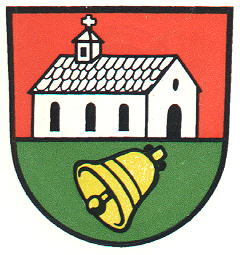Böbingen an der Rems: Difference between revisions
Knorrepoes (talk | contribs) No edit summary |
Knorrepoes (talk | contribs) m (Text replace - "[[Literature" to "{{media}} [[Literature") |
||
| Line 19: | Line 19: | ||
The upper half shows the so-called Kolomans-chapel in the village. The lower half shows a bell, which is derived from a local legend, in which wild boar suddenly found a buried bell near the village. As there have been Roman objects found near the village, the bell was chosen as a symbol for the long history of inhabitation in the village. | The upper half shows the so-called Kolomans-chapel in the village. The lower half shows a bell, which is derived from a local legend, in which wild boar suddenly found a buried bell near the village. As there have been Roman objects found near the village, the bell was chosen as a symbol for the long history of inhabitation in the village. | ||
{{media}} | |||
[[Literature]] : Bardua, 1987 | [[Literature]] : Bardua, 1987 | ||
Revision as of 19:40, 8 July 2014
| Heraldry of the World Civic heraldry of Germany - Deutsche Wappen (Gemeindewappen/Kreiswappen) |
BÖBINGEN AN DER REMS
State : Baden-Württemberg
District (Kreis) : Ostalbkreis (until 1973 Schwäbisch Gmünd)
Official blazon
In geteiltem Schild oben in Rot eine auf der Teilung stehende silberne Kapelle mit Dachreiter, unten in Grün eine schräglinke goldene Glocke
Origin/meaning
The arms were devised in 1930 for the municipality of Unterböbingen, which was later renamed to Böbingen an der Rems.
The upper half shows the so-called Kolomans-chapel in the village. The lower half shows a bell, which is derived from a local legend, in which wild boar suddenly found a buried bell near the village. As there have been Roman objects found near the village, the bell was chosen as a symbol for the long history of inhabitation in the village.
Contact and Support
Partners:
Your logo here ?
Contact us
© since 1995, Heraldry of the World, Ralf Hartemink 
Index of the site
Literature : Bardua, 1987











